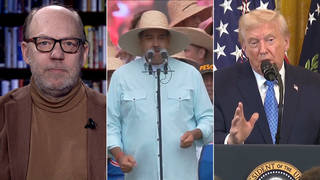
Guests
- Catherine Crumpstaff attorney with the American Civil Liberties Union.
- George Schulzworks with the Center for Investigative Reporting. He is one of the reporters who runs the Homeland Security Project.
A new report by the Center for Investigative Reporting reveals that since 9/11, local law enforcement agencies have used $34 billion in federal grants to acquire military equipment such as bomb-detection robots, digital communications equipment and Kevlar helmets. “A lot of this technology and the devices have been around for a long time. But as soon as they have, for instance, a law enforcement capability, that’s a game changer,” says George Schulz, with the Center for Investigative Reporting. “The courts and the public have to ask, how is the technology being used by a community of people—police—who are endowed with more power than the rest of us?’” Local police departments have also added drones to their toolkit. In June, a drone helped local police in North Dakota with surveillance leading to what may be the first domestic arrests with help from a drone. The American Civil Liberties Union has issued a new report that calls on the government to establish privacy protections for surveillance by unmanned aerial drones, especially of people engaged in protests. “We believe that people should not be targeted for surveillance via drones just because they’re they are engaged in First Amendment-protected activity,” says Catherine Crump, a staff attorney with the American Civil Liberties Union. [includes rush transcript]
Transcript
AMY GOODMAN: We turn now to a new report which shows, in the 10 years since 9/11, police departments across the country have acquired more and more military equipment. The authors write, “If terrorists ever target Fargo, North Dakota, the local police will be ready. In recent years, they have bought bomb-detection robots, digital communications equipment and Kevlar helmets, like those used by soldiers in foreign wars.” For local siege situations requiring real firepower, the report notes officers can use a new $256,000 armored truck which has a rotating gun turret. The report, published by the Center for Investigative Reporting, finds police increasingly rely on quasi-military tactics and equipment acquired with the $34 billion in federal grants disbursed across the country since September 11, 2001.
Local police departments have also added unmanned Predator drones to their tool kit. Earlier this month, the Los Angeles Times revealed new details about how domestic law enforcement agents have begun using unmanned drones inside the United States. In June, an unmanned Predator drone helped local police in North Dakota with surveillance leading to the arrest of three people. According to the Los Angeles Times, the incident marked the first time American citizens have been arrested domestically with the help from a Predator drone.
Now the American Civil Liberties Union has issued a new report that calls on the government to put protections in place to guard Americans’ privacy from surveillance by these unmanned aerial drones.
To talk more about this, we’re joined by George Schulz, who is with the Center for Investigative Reporting, one of the reporters who runs the Homeland Security Project. He’s joining us by Democracy Now! video stream. We’re also joined in our studio by Catherine Crump, senior—she’s a staff attorney with the American Civil Liberties Union, and she co-authored the report by the ACLU on the domestic use of drones.
Catherine, let’s start by laying out the story, for example, in North Dakota, where many of these stories around the militarization of police seem to focus. But tell us what happened there.
CATHERINE CRUMP: Well, in North Dakota, the police were engaged in a law enforcement action, and they thought that it would be to their benefit to have a drone take a view of the scene, and so they called on the federal government to help them. And Customs and Border Protection essentially loaned the local police a drone and helped them identify some suspects on private property, but also were able to tell, for instance, whether those individuals were armed. Now, in this particular instance, the police agents did have a warrant. But I think this broader story is showing how drones, and in fact other militaristic technologies, are increasingly being used for domestic law enforcement in ways that the American public doesn’t fully understand.
AMY GOODMAN: Talk about—just discuss this further. Expand it from North Dakota. How are the drones being used?
CATHERINE CRUMP: Well, you know, in some extent, we don’t know. But it is clear that local police departments are keenly interested in getting a hold of drones. Helicopter technology is very expensive, but drones are cheap. And there aren’t legal protections in place to preserve Americans’ privacy when these are used. And so, we face a real possibility that drones will be used by law enforcement agents across the country with very little regulation. And the ACLU published a report on this because we think it’s vitally important that privacy protections be put in place now, so that before drones come to the U.S. airspace, there are rules and regulations in place to make sure we’re all safe from pervasive surveillance.
AMY GOODMAN: Now, in North Dakota, they had been using the drones for the border. And so, when they wanted to move in—and maybe you could explain more fully what this story was in North Dakota.
CATHERINE CRUMP: Well, the police actually were engaging in an investigation about some stolen cows, actually, and they were concerned that the people who were on the property were armed. And so, they asked—they called in the Border Patrol and said, “Hey, could you help back us up in this operation, and could you help us by engaging in drone surveillance?” And they did that and were able to give the police information about who was on the property and whether or not they had weapons. And it’s just—it’s a remarkable story, because although—even those of us who follow the use of drones quite closely weren’t aware that the federal government was actually loaning out its drones to local agencies to engage in surveillance. And then that, of course, poses the prospects that even smaller police departments are using this extremely advanced technology to engage in surveillance.
AMY GOODMAN: We’re also joined by George Schulz, who is looking at the so-called toolkit of police, of which now drones is being—drones are being added, one of the reporters who runs the Homeland Security Project, who put out this report on the militarization of police. George Schulz, talk about the use of drones and—well, and much more, when it comes to stockpiling equipment by police in this country.
GEORGE SCHULZ: Now drones are among a number of 21st century technologies that local police in the United States are adopting very, very rapidly. And it’s a number of factors that are contributing to this. You know, prior to September 11th, there was a sort of militarization of police already underway as a result of the drug war, and now the rise of task forces and a couple of programs that enabled local police departments to acquire decommissioned equipment from the military. But after 9/11, there was an additional spending spree through federal Homeland Security grants that made it easier for police departments, large and small, in the United States to acquire equipment they couldn’t necessarily afford before or necessarily justify buying.
So, what we did was set out to approach every state in the United States, through open government laws, to try to collect records showing how communities were spending Homeland Security grants. And basically, what Congress did after 9/11 was say, “Well, communities around the country need to be ready for another 9/11-style attack, so we need to start funding preparedness programs.” But the list of items you could buy every day grew bigger and bigger and bigger, because all of it feasibly could be used to help prepare for a terrorist attack. But terrorism scenarios are fairly unlikely in the U.S., so a lot of this equipment was being used for everyday law enforcement, if it was being used at all. Right? So what we saw among a lot of police departments was the purchase of combat-style equipment, tactical equipment—combat helmets, really expensive tactical vests, tactical shields, breach-entry equipment for tactical raids. Basically, you can buy anything you want with Homeland Security grants except the guns.
So what we saw parallel to the purchase of combat-style equipment with Homeland Security grants was also a wider adoption of the use AR-15 and M-16 military-style assault rifles. And when we talked to folks in the law enforcement community about that, part of the reason they were adopting that use, even though it was occurring to an extent before 9/11, a lot of the folks were pointing to events like the Mumbai attacks in India and terrorist attacks like that that were sort of lower-level and involved attackers using assault rifles, small explosive devices, things like that. So then bigger cities like Los Angeles and Las Vegas became concerned that if an event like that were to be replicated here, their officers would need things like AR-15 assault rifles to fight back. So, there were basically two tracks here over the last several years that we saw: the spending spree from Homeland Security grants on military-style protective gear and then the wider adoption of the use of AR-15s and M-16s among everyday patrol officers in the U.S.
AMY GOODMAN: Last month I spoke with the former chief of police of Seattle, Norm Stamper, who was the police chief in charge during the Battle of Seattle in November 1999. He wrote a critical article for The Nation magazine entitled “Paramilitary Policing from Seattle to Occupy Wall Street.”
NORM STAMPER: I do believe that since 1999 and the Battle in Seattle there have been many changes. My concern is, many of those changes have been for the worse. The officers, for example, in Oakland were dressed as my police officers were in Seattle, which is, in effect, for full—in full battle gear. We were using military tactics. I authorized the use of chemical agents on nonviolent offenders. I thought I had good justification at that time. I did not. The police officer in me was thinking about emergency vehicles, fire trucks, aid cars being able to get through a key intersection. The police chief in me should have said, “This is wrong,” and vetoed that decision. I will regret that decision for the rest of my life. We took a military response to a situation that was fundamentally nonviolent, in which Americans were expressing their views and their values, and used tear gas on them. And that was just plain wrong.
AMY GOODMAN: George Schulz, if you could respond to what the former chief of police of Seattle, Norm Stamper, had to say, as we see these militarized police everywhere from the Occupy Wall Street encampments to the Republican and Democratic conventions that we went through and are going to be dealing with again in Tampa and Charlotte?
GEORGE SCHULZ: Well, it was pretty extraordinary to see that op-ed from Chief Stamper. In the law enforcement community, the After Action Report from the so-called Battle in Seattle, it still circulates to this day as a document that warns other cities about what could happen if they allow protests to grow out of control. I mean, I hear police departments talk about those events to this day, and they’re petrified that an event like that is going to occur on their streets, and if they don’t control it early on, it’s going to be egg on their face. So I think that’s why you see these sort of aggressive responses to protesters, because a lot of law enforcement folks think back to Seattle, and they don’t want a perception globally that they’re allowing things to grow out of control.
But 10 years out, we’ve seen police respond to protests in a variety of different ways over the last decade. And we’ve seen some cities take what you might call a non-militaristic approach, where they have taken their time and attempted to negotiate, for instance, with Occupy protesters, over decamping rather than sort of rushing in to use force or gas, whatever is believed to be necessary to deal with those protesters. And what I think we’ve seen departments, especially in the last few months, demonstrate is that there are alternatives. There are a few different approaches you can take. And that’s, I think, what Chief Stamper is trying to indicate, that there were alternatives he could have used back then, and he didn’t, and he regrets that today. And it was pretty compelling to hear him say that.
AMY GOODMAN: Catherine Crump, I wanted to go back to the use of drones. We have an act, the Posse Comitatus Act, that said the military can’t operate here on U.S. soil. Explain then, are they getting around it by militarizing the police, bringing in National Guard? What have you found in your report?
CATHERINE CRUMP: Well, one way this works is that the federal law enforcement agencies have this technology and can simply lend it to the local law enforcement agencies. But actually the more alarming prospect is that drones are so cheap that any local surveillance—any local police department can afford them now. You have the large drones that are used in places like Iraq and Yemen, but you also have very small drones that can be used for local law enforcement agencies. They can—local law enforcement, they can stay aloft for a long time. They can have cameras that zoom in in great detail. They have thermal imaging that can allow the law enforcement agents to see things that aren’t visible with the naked eye. And I think this raises the prospect for a real transformation in American life.
AMY GOODMAN: We have visitors today from Colorado, from our radio station KGNU, community radio station in Boulder and Denver. Talk about Colorado, for example.
CATHERINE CRUMP: Well, Colorado is one state in which the police have gotten a hold of drones. But it’s really just one example of a broader phenomenon. Think about—
AMY GOODMAN: They got FAA approval.
CATHERINE CRUMP: They did get FAA approval. You know, so far, one reason we haven’t seen a great availability of drones is that the FAA has by and large stopped broader surveillance. However, the FAA is under tremendous pressure from industry and its allies in Congress to loosen the rules and to allow broader use of drones. And before that happens, it’s extremely important that there be safety—regulations put in place to preserve privacy, to make sure that drones don’t become a force for pervasive surveillance and instead are only used in limited circumstances.
AMY GOODMAN: So, we’re talking about drones for surveillance. Of course, drones can drop bombs. What about drones tasering?
CATHERINE CRUMP: Yes, that’s a very interesting point. Drones are known for having cameras attached to them. And overseas, they’ve been used to drop bombs. But actually, they can be used to deliver other kinds of force. For example, tasers. And while no local law enforcement agencies are currently using drones in that way, manufacturers are excitingly equipping them so that they can use that type of technology. And one police department in Texas has actually acquired drones that are capable of using that type of force.
AMY GOODMAN: And bombs?
CATHERINE CRUMP: Well, we haven’t heard about that yet, but, you know, technology is what it is. And it’s important to regulate it before it’s used in ways that Americans wouldn’t have anticipated five years ago and that seriously infringe on our freedoms.
AMY GOODMAN: And the recommendations around the issue of privacy in the use of drones that the ACLU is making now with this report?
CATHERINE CRUMP: Well, we recommend, first of all, that drones should only be used where the police have a reasonable suspicion to believe that there’s some criminal activity going on. And that’s specifically talking about drones for surveillance purposes. We also recommend that images not be—of identifiable people not be retained, where those people aren’t engaged in wrongdoing. And important to the protest issues that have been the focus of much of our attention these days, we believe that people should not be targeted for surveillance via drones just because they’re engaged in First Amendment-protected activity. Americans shouldn’t have to fear that when they go out and engage in lawful protest activity, that they’re going to be subject to surveillance by drones.
AMY GOODMAN: And just on that issue of Posse Comitatus, it applies to the U.S. Army and Air Force on U.S. soil, but not the National Guard?
CATHERINE CRUMP: Well, it applies to the Army and Air Force, but it doesn’t apply, for instance, to Customs and Border Protection, which has drones that it’s currently using to patrol the border. And one concern is that federal agencies will make their drones available to local law enforcement, as has happened in North Dakota, as we started out discussing.
AMY GOODMAN: George Schulz, the Center for Investigative Reporting report that you have just co-authored, “Local Police Stockpile High-Tech, Combat-Ready Gear,” what were you most surprised by, as we wrap up this discussion?
GEORGE SCHULZ: I guess, you know, in the end, I think it was the dollar volumes that we were looking at. These programs, year after year, Congress was funding them with a few billion dollars a year, to the point that we’ve reached $34 billion 10 years after September 11th. And it was just such an explosion of spending that we hadn’t seen before. Some of these grant programs existed before 9/11, but they weren’t funded anywhere near what they were after September 11th. And there’s such, at this point, a dizzying array of grant programs that communities are eligible for, and the list goes on and on. If you don’t get a piece of equipment you want from one grant program, you can turn to another one and apply for that one. And there are similar programs available through the Justice Department. I think that was a key point that Catherine was making, was that the drone that was used in North Dakota was CBP-controlled, so it didn’t have anything to do with the military. It was a federal law enforcement agency sharing its equipment with the local law enforcement agency. And that’s a type of resource sharing I think you’re going to—it’s going to be really, really common.
But the courts on public opinion are struggling to keep up with a lot of this technology. We’re discussing drones today, but we could just as likely be discussing license plate scanners—an enormous amount of data is accumulated through license plate scanners—public surveillance cameras, remote digital fingerprinting. There are loads of these technologies that, when you think from a law enforcement perspective, it’s no surprise they want to use them. In their mind, it makes their job easier.
AMY GOODMAN: And then there’s, of course, the issue of then corporate use of drones.
GEORGE SCHULZ: Yeah, absolutely. It could eventually be an issue. How are private citizens going to use these aircraft? I mean, some of the equipment that’s being used, like Catherine said, it’s—they’re basically remote-controlled helicopters with a—small remote-controlled helicopters with a camera affixed to them. A lot of this technology and the devices have been around for a long time. But as soon as they have, for instance, a law enforcement capability, that’s a game changer. And if departments are using them more broadly, the courts have to and the public have to ask, how is the technology being used by a community of people—police—who are endowed with more power than the rest of us?
AMY GOODMAN: George Schulz, I want to thank you very much for being with us, Center for Investigative Reporting. Your report, “Local Police Stockpile High-Tech, Combat-Ready Gear.” And Catherine Crump, with the American Civil Liberties Union, co-author with Jay Stanley of the ACLU’s report on the domestic use of drones called “Protecting Privacy from Aerial Surveillance: Recommendations for Government Use of Drone Aircraft.” We’ll link to both of your reports. Thanks so much.












Media Options